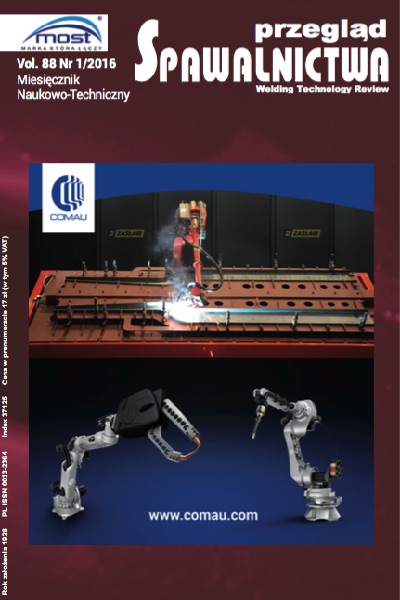Czy można rozmawiać z robotem spawalniczym?
##plugins.themes.bootstrap3.article.main##
Abstrakt
W artykule przedstawiono zagadnienia związane ze sterowaniem głosowym robotami przemysłowymi, w tym robotami spawalniczymi. Omówiono celowość wy- korzystania automatycznego rozpoznawania mowy w ro- botyce, potencjalny zakres zastosowań oraz specyficzne wymagania dotyczące aplikacji sterowania głosowego związanych z robotami przemysłowymi. W szczególno- ści skoncentrowano się na głosowym wspomaganiu pro- gramowania robotów przez uczenie. Poruszone zostało zagadnienie definiowania języka komend głosowych oraz różne aspekty integracji systemu rozpoznawania mowy z układem sterowania robota przemysłowego. Rozważa- nia poparto przykładami ze zrealizowanej implementacji sterowania głosowego robotem Movemaster.
Can we talk to a welding robot?
Abstract
Current paper deals with various aspects of voice control system that could be applied to industrial robots, particularly in welding applications. It discusses the usefulness of voice-based human-machine interfaces, potential areas of application, restrictions as well as spe- cific requirements regarding these systems. In particular, it focuses on speech-aided teach-in robot programming. A separate chapter is dedicated to the issue of voice command language description. Integration of speech recognition system and robot controller is also broadly discussed. Description of these issues is illustrated by example of practically implemented voice control system applied to educational robot Movemaster.
Pobrania
##plugins.themes.bootstrap3.article.details##
Creative Commons CC BY 4.0 https://creativecommons.org/licenses/by/4.0/
Artykuły czasopisma Welding Technology Review (Przegląd Spawalnictwa) publikowane są w otwartym dostępie na licencji CC BY (licencja Creative Commons Uznanie autorstwa 4.0 Międzynarodowe). Licencja CC BY jest najbardziej otwartą dostępną licencją i uważaną za „złoty standard” w formule otwartego dostępu; jest również preferowany przez wielu fundatorów badań. Licencja ta umożliwia czytelnikom kopiowanie i redystrybucję materiału na dowolnym nośniku i w dowolnym formacie, a także zmienianie, przekształcanie lub budowanie na nim materiału, w tym do użytku komercyjnego, pod warunkiem wskazania oryginalnego autora.
Bibliografia
V. Kulyukin: Human-Robot Interaction Through Gesture-Free Spoken Dialogue, Autonomous Robots, Vol. 16, s. 239-257, 2004.
J. Bos, T. Oka: A spoken language interface with a mobile robot, Artificial Life and Robotics, Vol. 11(1), s. 42-47, 2007.
J. Savage i in.: VIRbot: a system for the operation of mobile robots, Lecture Notes in Computer Science, Vol. 5001, s. 512-519, 2008.
M. Yokota, K. Sugita, T. Oka: Natural language understanding based on mental image description language Lmd and its application to language-centered robot manipulation, Artificial Life and Robotics, Vol. 13(1), s. 84-88, 2008.
T. Oka i In.: RUNA: a multimodal command language for home robot users, Artificial Life and Robotics, Vol. 13(2), s. 455-459, 2009.
J. Pires: The Industrial robot as a human coworker: the role of the
speech interfaces, materiały konferencyjne: International Conference on Software Development for Enhancing Accessibility and Fighting Info-exclusion, Portugal, 2007.
M. Zaeh, W. Roesel: Safety aspects in a human-robot interaction scenario: a human worker is co-operating with an industrial robot, Progress in Robotics, Vol. 44(2), s. 53-62, 2009.
A. Weiss i in.: Exploring human-robot cooperation possibilities for semiconductor manufacturing, materiały konferencyjne: International Conference on Collaboration Technologies and Systems, Philadelphia, PA, USA, s. 173-177, 2011.
A. Rogowski: Głosowa komunikacja człowiek-maszyna w gniazdach obróbkowych o zróżnicowanym stopniu automatyzacji, Zeszyty Na- ukowe Politechniki Poznańskiej 15, s. 131-144, 2011.
A. Rogowski: Projekt i implementacja systemu programowania i sterowania gniazdem zrobotyzowanym przez Internet, Prace Naukowe Politechniki Warszawskiej, seria Elektronika 175, s. 311-320, 2010.
A. Rogowski: Remote programming and control of the flexible machining cell, International Journal of Computer Integrated Manufacturing, Vol. 28(6), s. 650-663, 2015.
J. Pires: Robot-by-voice: Experiments on commanding an industrial robot using the human voice, Industrial Robot, Vol. 32(6), s. 505-511, 2005.
G. Veiga, J. Pires, K. Nilsson: Experiments with service-oriented architectures for industrial robotic cells programming, Robotics and Computer-Integrated Manufacturing, Vol. 25(4-5), s. 746-755, 2009.
A. Rogowski: Industrially oriented voice control system, Robotics and Computer-Integrated Manufacturing, Vol. 28(3), s. 303-315, 2012.
G. Tunnell, Ch. Pomernacki, J. Gregg: Voice controlled welding system, Patent US 4641292A, 1987.
T. Fong, C. Kunz, L. Hiatt, M. Bugajska: The Human-Robot Interaction Operating System, materiały konferencyjne: 1st ACM SIGCHI/ SIGART conference on Human-robot interaction, Salt Lake City, Utah, USA s. 41-48, 2006.
S. Profanter, A. Perzylo, N. Somani, M. Rickert, A. Knoll: Analysis and Semantic Modeling of Modality Preferences in Industrial Human- Robot Interaction, IEEE/RSJ International Conference on Intelligent Robots and Systems (IROS) Hamburg, Germany, 2015.
A. Rogowski: Analiza i synteza systemów sterowania głosowego w zrobotyzowanym wytwarzaniu, Prace Naukowe Politechniki Warszawskiej, Mechanika z. 244, 2012.
V. Kulyukin: Talk the Walk: robotic NLP vs. human sublanguage acquisition, AAAI Spring Symposium on Multidisciplinary Collaboration for Socially Assistive Robotics, Palo Alto, CA,USA s. 33-35, 2007.
A. Rogowski: Web-based remote voice control of robotized cells, Robotics and Computer-Integrated Manufacturing, Vol. 29(4), s. 77-89, 2013.
M. Stenmark, P. Nugues: Natural Language Programming of Industrial Robots, International Symposium on Robotics (ISR) Seoul, Korea, 2013.
